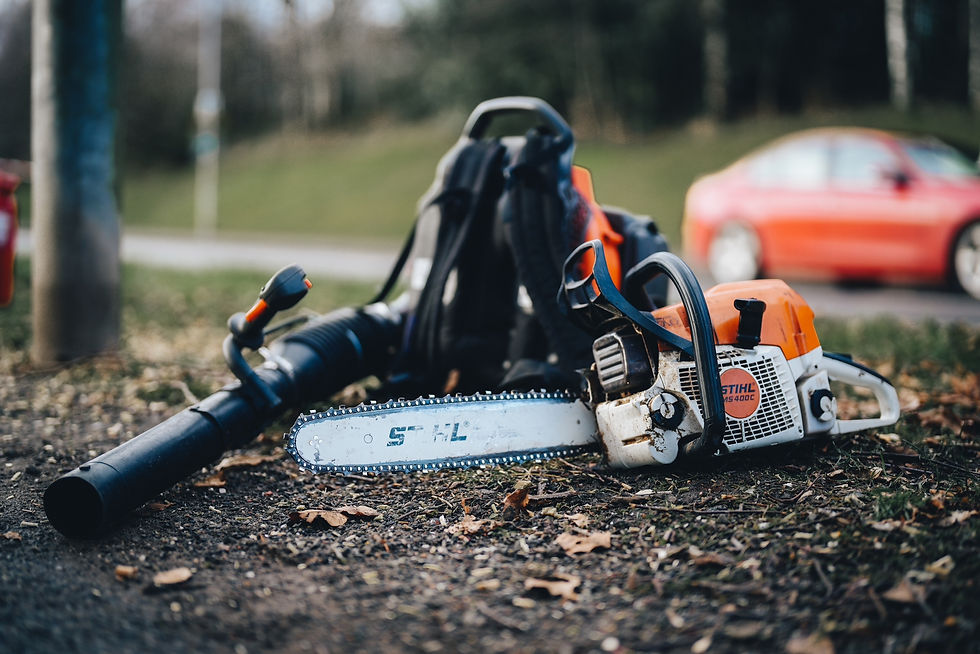Removing a large Ash with Die-Back
- Neil Foote

- Jan 12, 2024
- 3 min read

Another post about Ash Dieback I'm afraid! I thought as a different idea for a blog I'd talk through what's required to remove a large tree with dubious structural integrity due to disease, in this case Hymenoscyphus Fraxinus. Hymeno is a Fungus that attacks the vascular system of a tree, specifically Fraxinus Excelsior, ultimately rendering it useless against secondry attacks from Pathogens. In this case I'm pretty certain the Fungus that finished this tree off was Armillaria, or Honey Fungis.
The tree itself was situated just outside Strathaven in South Lanarkshire, in a very rural setting.....so rural it was impossible to get our chip truck and chipper up the track to the house, so we moved all our gear up via the Hilux. Our clients property was surrounded by an amazing array of trees, ranging from Beech to Sycamores and some of the trees on their property where in excess of 200 years old. We have a number of scheduled works to do for them, from felling to pruning, however the first, most pressing job was to remove the Ash that was worryingly close to their house and already showing advanced signs of Dieback.
A survey on the property in December carried out by ourselves raised a number of red flags. Signs of Hymenoscyphus include; Epicormic growth, "diamond" shaped lesions on the trunk, branches and twigs; lateness to leaf, premature leaf drop in Autumn and an overall colour change in branches to an almost golden colour. Further tests confirmed that the main Trunk was indeed hollow and was at risk in the near future of complete failure.

Just because a tree such as this has advanced Die-Back, doesn't necessarily mean a full removal has to be done. There are many options, from a heavy prune, to a full pollard to take weight out of the crown and reduce leverage. However it was agreed that the client had no particular attachment to this tree, the main stem could damage the property if it failed, even with a heavy reduction, a heavy reduction would look unsightly, and the property already had a huge amount of mature trees. There was also a high likelihood of the larger Branches shearing off onto an area that was used as Access to the house and parking, making the risk of keeping the tree too high. So the decision was made to schedule a full removal.
Interestingly the Tree was measured by us at 1.2 meters DBH. DBH means "Diameter at Breast Height", and is one of the measurements we take when surveying trees. We can get a rough idea of the age of the tree by taking the DBH; 120cm x 3.14 (Pi) (to give us the Circumference) = 376cm and dividing this by 2.5cm (the annual girth added by the growth rings each year) giving us the rough age of 150 years old.
DBH X 3.14 / 2.5 = Age
Obviously there are a number of concerns when climbing and dismantling a tree that has advanced disease. Our first option when doing so is to always use a Spider Lift, which mitigates the dangers of putting loads onto anchors, and takes away the danger to the climber, ground crew, members of the public and property, however in this case, due to the access issues a MEWP (Mobile Elevated Work Platform) was out of the question. In this case we where lucky that there where only two large limbs that had to be lowered, one over a poly tunnel, and another over

the roof of the house. The majority of the tree could be cut and dropped, reducing the risk of shock loading an already dubious main stem.
Luckily for us, this job was what we call a "chop and drop", which means that all "waste" from the tree removal would be dealt with by the clients. We like this sort of agreement, as it means that we can carry out the work that we love doing, whilst not having to worry about Chipping and removing heavy logs which can be, more often than not, labour intensive. It also gives the client the opportunity to recoup a large amount of the price of such a job in the amount of firewood they'll gain from their own tree, in most cases it's easily £200-£300 for a job such as this. The other great thing is that we're not running any heavy machinery....no chipper or Arb truck, which reduces our carbon footprint. We already recycle all of our Arb waste for Biomass fuel, but its always nice to see people benefit from the negative side of removing their trees.


.png)


Comments